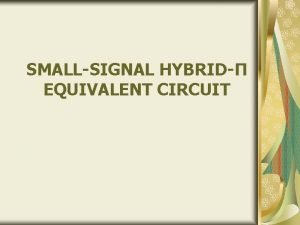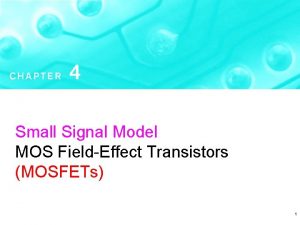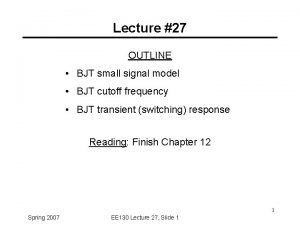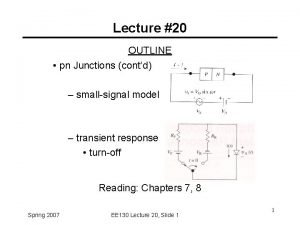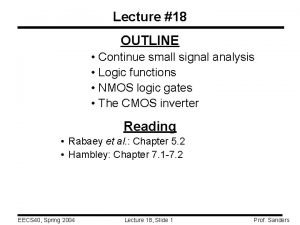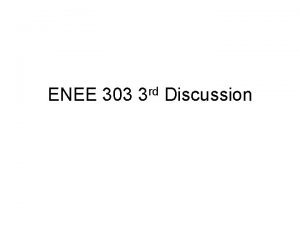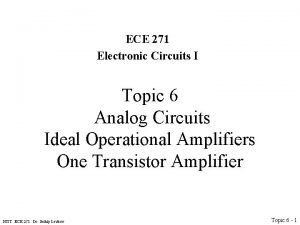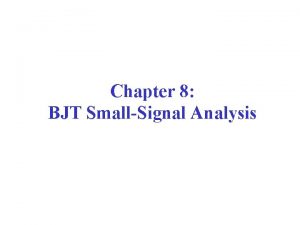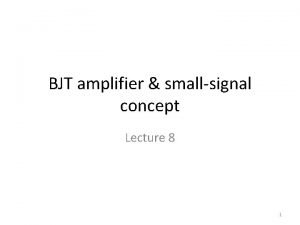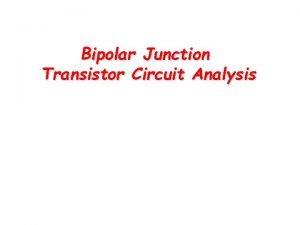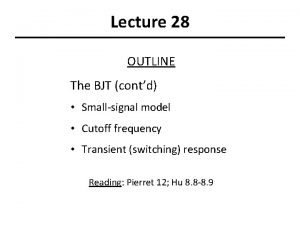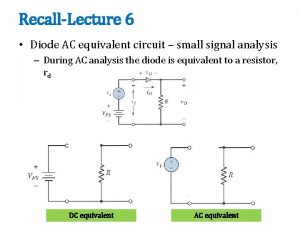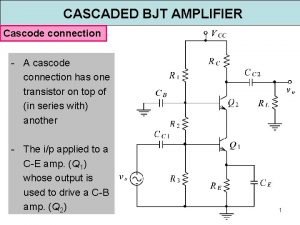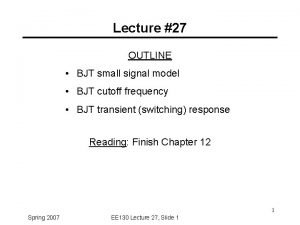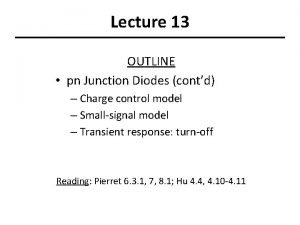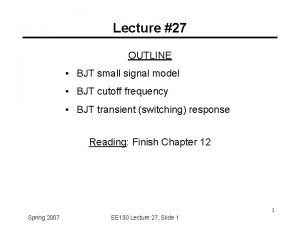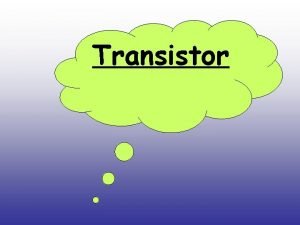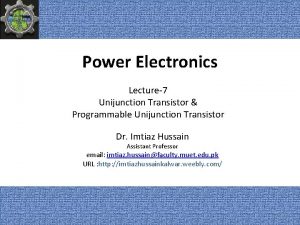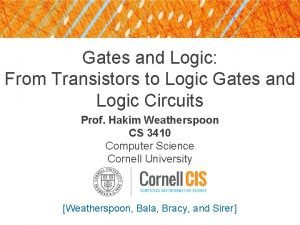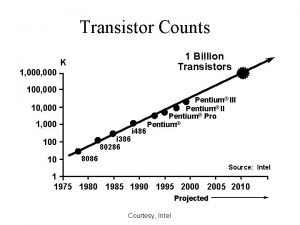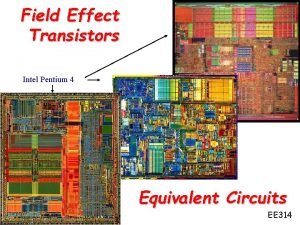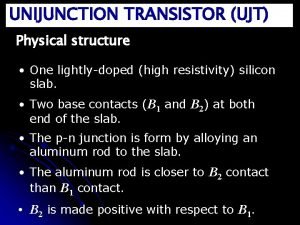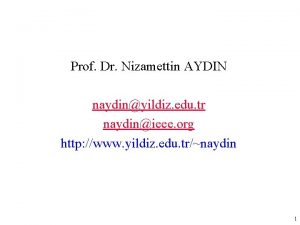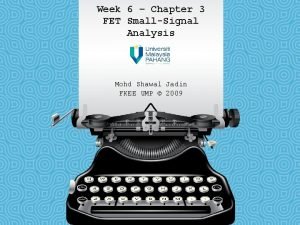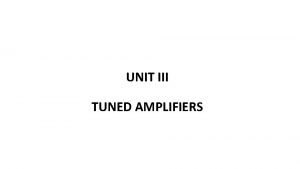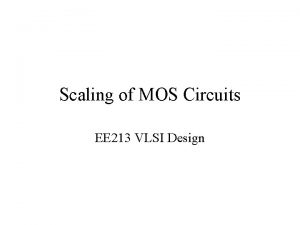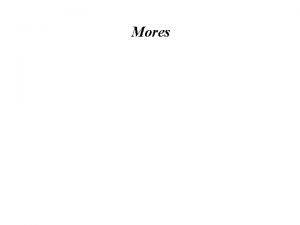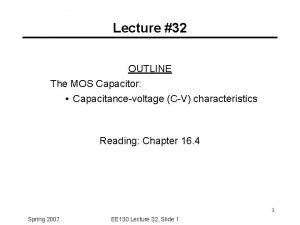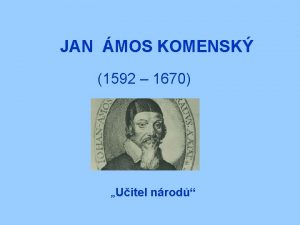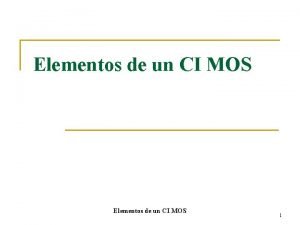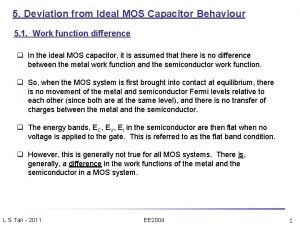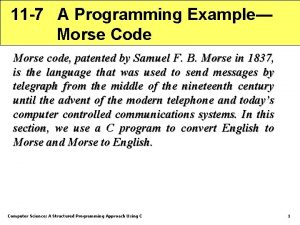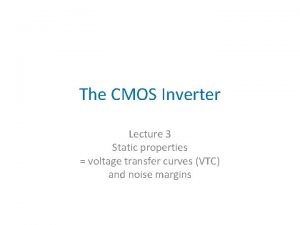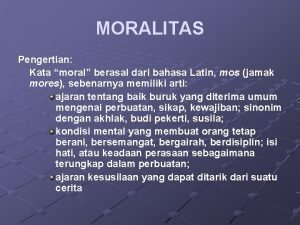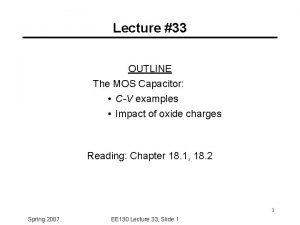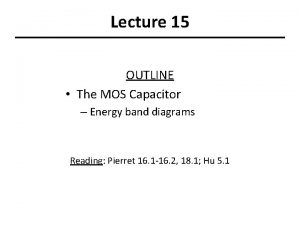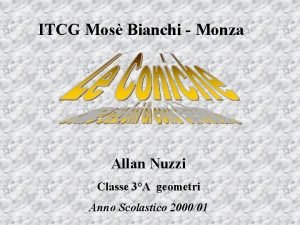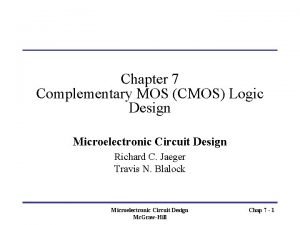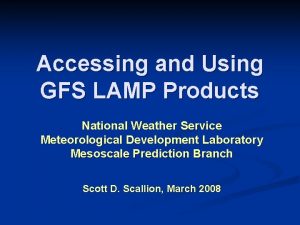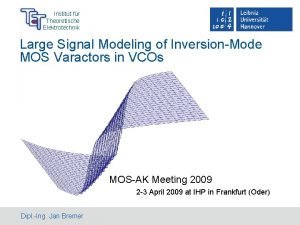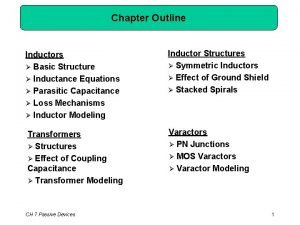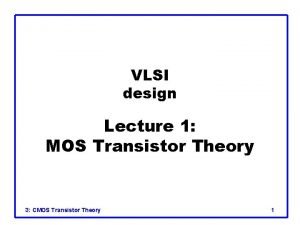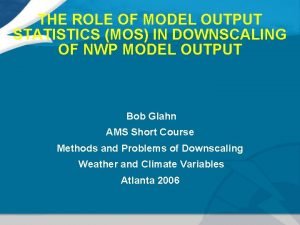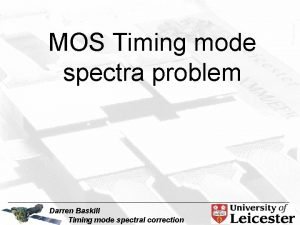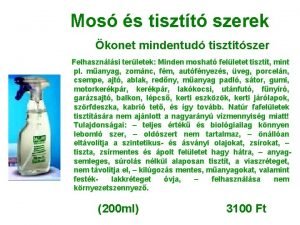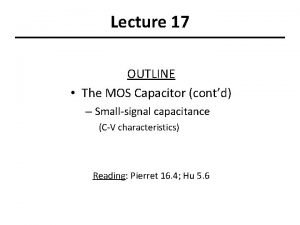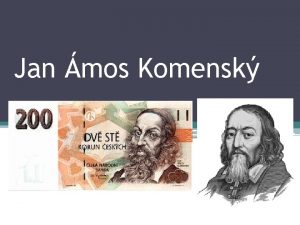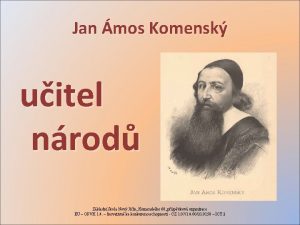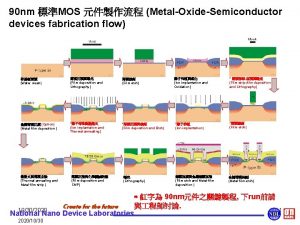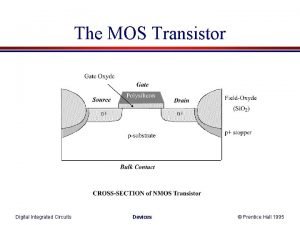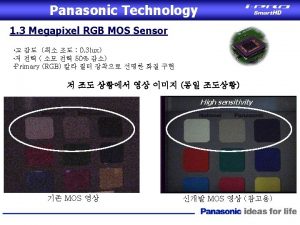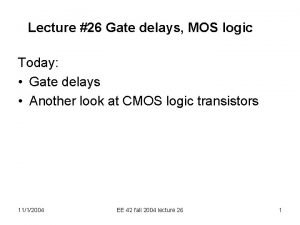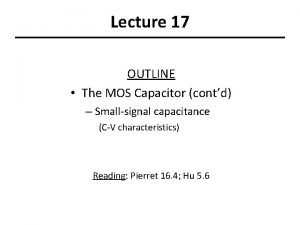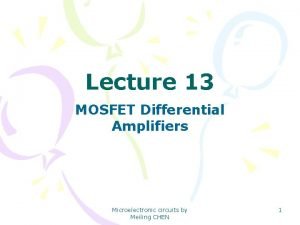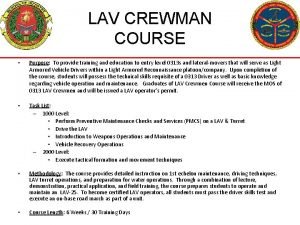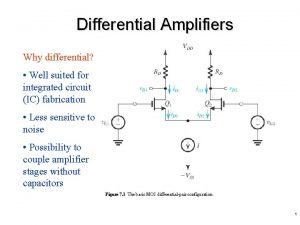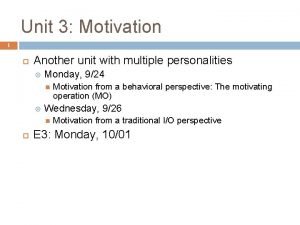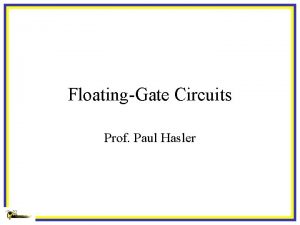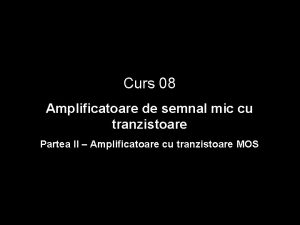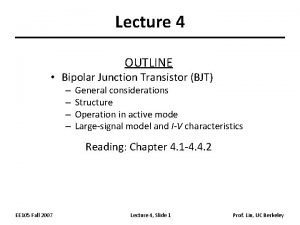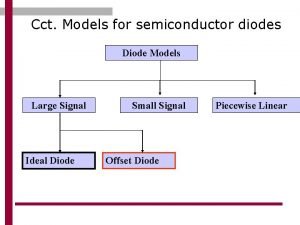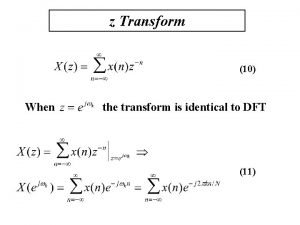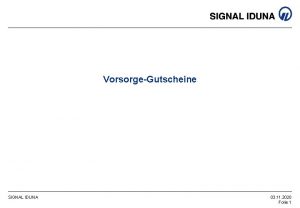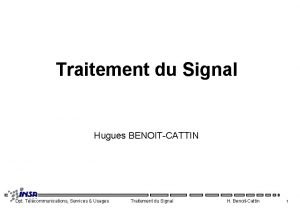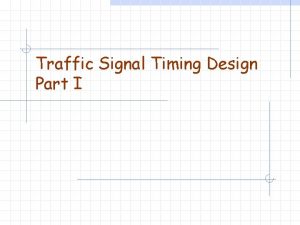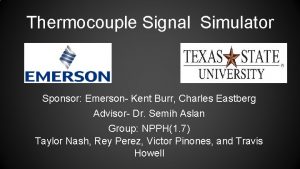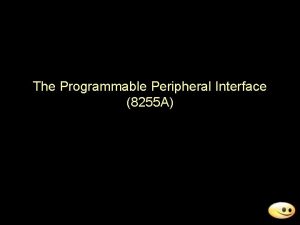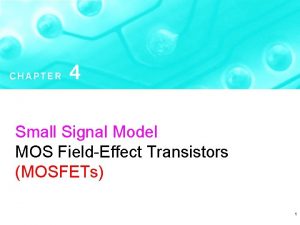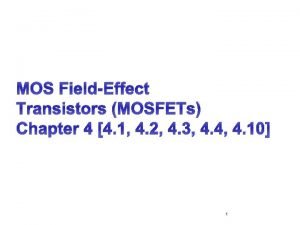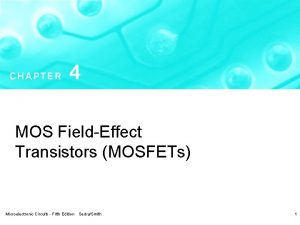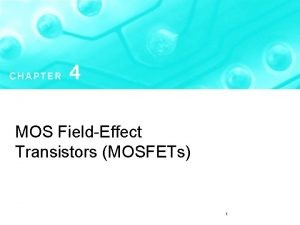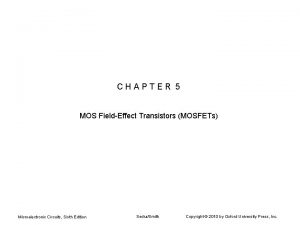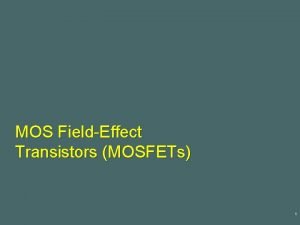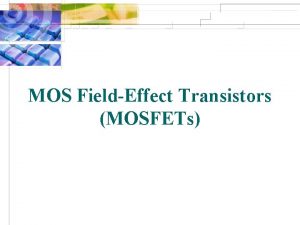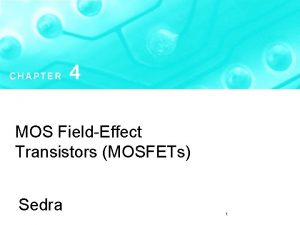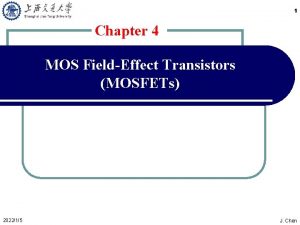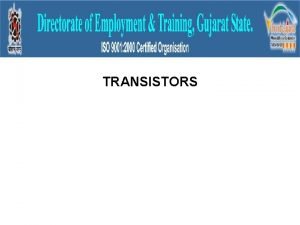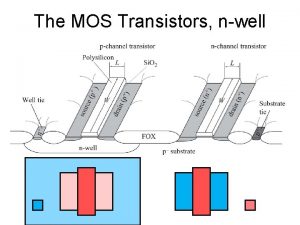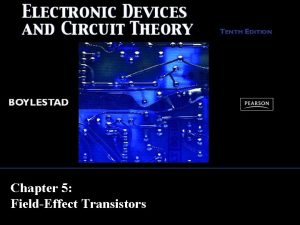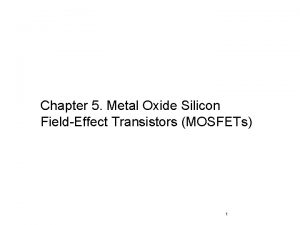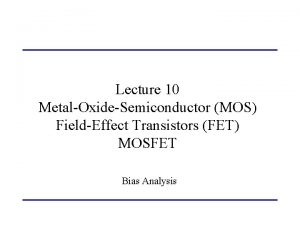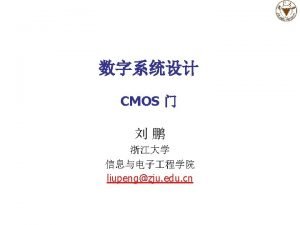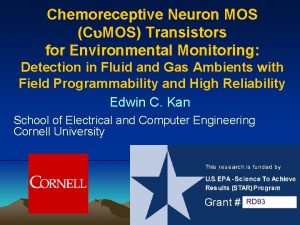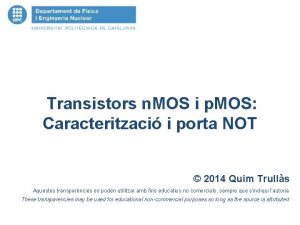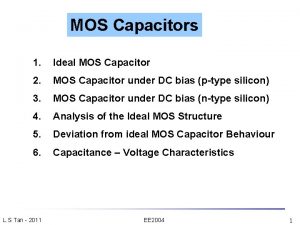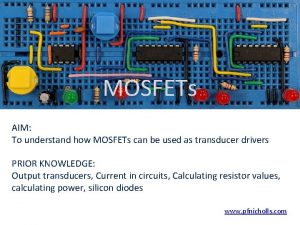Small Signal Model MOS FieldEffect Transistors MOSFETs 1




































































































- Slides: 100

Small Signal Model MOS Field-Effect Transistors (MOSFETs) 1

Quiz No 3 DE 27 (CE) 20 -03 -07 Rout. (a) (b) (c) Draw small signal model (4) Find expression for Rout (2) Prove vo/vsig = (β 1α 2 RC)/(Rsig+rπ) (4).

Figure 4. 2 The enhancement-type NMOS transistor with a positive voltage applied to the gate. An n channel is induced at the top of the substrate beneath the gate.

Enhancement-type NMOS transistor:

MOSFET Analysis i. D = i. S, i. G = 0

Large-signal equivalent-circuit model of an n-channel MOSFET : Operating in the saturation region.

Large-signal equivalent-circuit model of an p-channel MOSFET : Operating in the saturation region.

Large Signal Model : MOSFET

Transfer characteristic of an amplifier

Conceptual circuit utilized to study the operation of the MOSFET as a small-signal amplifier. The DC BIAS POINT To Ensure Saturation-region Operation

Signal Current in Drain Terminal

Total instantaneous voltages v. GS and v. D

Small-signal ‘π’ models for the MOSF

Common Source amplifier circuit Example 4 -10

Small Signal ‘T’ Model : NMOSFET

Small Signal Models ‘T’ Model

Single Stage MOS Amplifier

Amplifiers Configurations

Common Source Amplifier (CS) : Configuration

Common Source Amplifier (CS) • Most widely used • Signal ground or an ac earth is at the source through a bypass capacitor • Not to disturb dc bias current & voltages coupling capacitors are used to pass the signal voltages to the input terminal of the amplifier or to the Load Resistance • CS circuit is unilateral – – Rin does not depend on RL and vice versa

Small Signal Hybrid “π” Model (CS)

Small Signal Hybrid “π” Model : (CS)

Small-signal analysis performed directly on the amplifier circuit with the MOSFET model implicitly utilized.

Common Source Amplifier (CS) Summary • Input Resistance is infinite (Ri=∞) • Output Resistance = RD • Voltage Gain is substantial

Common-source amplifier with a resistance RS in the source lead

The Common Source Amplifier with a Source Resistance • The ‘T’ Model is preferred, whenever a resistance is connected to the source terminal. • ro (output resistance due to Early Effect) is not included, as it would make the amplifier non unilateral & effect of using ro in model would be studied in Chapter ‘ 6’

Small-signal equivalent circuit with ro neglected.

Small-signal Analysis.

Voltage Gain : CS with RS

Common Source Configuration with Rs • Rs causes a negative feedback thus improving the stability of drain current of the circuit but at the cost of voltage gain • Rs reduces id by the factor – (1+gm. Rs) = Amount of feedback • Rs is called Source degeneration resistance as it reduces the gain

Small-signal equivalent circuit directly on Circuit

A common-gate amplifier based on the circuit

Common Gate (CG) Amplifier • The input signal is applied to the source • Output is taken from the drain • The gate is formed as a common input & output port. • ‘T’ Model is more Convenient • ro is neglected

A small-signal equivalent circuit

A small-signal Analusis : CG

A small-signal Analusis : CG

Small signal analysis directly on circuit

The common-gate amplifier fed with a current-signal input.

Summary : CG 4. CG has much higher output Resistance 5. CG is unity current Gain amplifier or a Current Buffer 6. CG has superior High Frequency Response.

A common-drain or source-follower amplifier.

Small-signal equivalent-circuit model

Small-signal Analysis : CD

(a) A common-drain or source-follower amplifier : output resistance Rout of the source follower.

(a) A common-drain or source-follower amplifier. : Smallsignal analysis performed directly on the circuit.

Common Source Circuit (CS)

Common Source Circuit (CS) With RS

Common Gate Circuit (CG) Current Follower

Common Drain Circuit (CD) Source Follower

Summary & Comparison

Quiz No 4 • Draw/Write the Following: Types Symbols ‘π’ Model T Model gm Re/rs rπ/rg BJT npn pnp MOSFET n. MOS p. MOS 27 -03 -07



Problem 5 -44

SOLUTION : DC Analysis

SOLUTION : DC Analysis IE IB Check for Active Mode

Solution Small Signal Analysis

Solution Small Signal Analysis

Solution Small Signal Analysis : Input Resistance ib + vb - Rin

Solution Small Signal Analysis : Output Resistance Itest IE IRC IE/(1+ß) Rout

Solution Small Signal Analysis : Voltage Gain + veb - - + Vo vi + -

Solution Small Signal Analysis : Voltage gain + veb + vi -

Solution Small Signal Analysis : Voltage Gain + vi -

Solution Small Signal Analysis : Voltage Gain

Solution Small Signal Analysis : Voltage Gain + vi - Vo +

Problem

Small Signal Model MOSFET : CD

Solution Small Signal Analysis 1/gm D gmvsg

Solution Small Signal Analysis : Input Resistance 1/gm Ig=0 D gmvsg Rin

Solution Small Signal Analysis : Output Resistance Itest 1/gm ID IG=0 IRD D gmvsg Rout Vtest

Solution Small Signal Analysis : Voltage Gain + vsg 1/gm - - + vi - gmvsg D +

Solution Small Signal Analysis : Voltage gain + vsg 1/gm + vi - D gmvsg

Solution Small Signal Analysis : Voltage Gain + vi -

Solution Small Signal Analysis : Voltage Gain

Solution Small Signal Analysis : Voltage Gain + vi - +

Solution Small Signal Analysis

Problem 6 -127(e)

DC Analysis 6 -127(e)

Small Signal Model

Small Signal Model

Small Signal Model Rin Rout

Problem 6 -127(f) Replacing BJT with MOSFET

Small Signal Model

Small Signal Model

Small Signal Model Rin Rout


Problem 6 -127(f)

Solution P 6 -127(f) + vbe 2 + veb 1 -

Solution P 6 -127(f) + vbe 2 + veb 1 + vi -

Problem 6 -127(f) with MOSFET

Solution P 6 -127(f) + vgs 2 + vsg 1 -

Solution P 6 -127(f) + vgs 2 + vsg 1 ig 1=0 + vi -

Comparison BJT/MOSFET Cct

Small Signal Model

Problem 6 -123 VBE=0. 7 V β =200 K’n(W/L)=2 m. A/V 2 Vt=1 V Figure P 6. 123

DC Analysis Figure P 6. 123

VBE=0. 7 V β =200 K’n(W/L)=2 m. A/V 2 Vt 1=1 V Vt 2=25 m. V DC Analysis 1 m. A 2 V IG 0. 7 V =0 I=0. 7/6. 8=0. 1 m. A

Small Signal Model

Small Signal Model

Small Signal Model : Voltage Gain + ig=0 vi - + vbe 2 -

Small Signal Model : Input Resistance ii + ig=0 vi Rin
 Bjt small signal
Bjt small signal T model mosfet
T model mosfet Bjt small signal model
Bjt small signal model Small signal model
Small signal model Small signal model of cmos inverter
Small signal model of cmos inverter Small signal model for pmos
Small signal model for pmos Small signal model of bjt
Small signal model of bjt Sedra
Sedra Linearized
Linearized Graphical analysis
Graphical analysis Transistor large signal model
Transistor large signal model Bjt kirk effect
Bjt kirk effect Small signal analysis diode
Small signal analysis diode Bjt cascade
Bjt cascade Small signal model bjt
Small signal model bjt Small signal model for pmos
Small signal model for pmos Small signal model bjt
Small signal model bjt How transistors work
How transistors work Ujt circuit diagram
Ujt circuit diagram Application des transistors bipolaires
Application des transistors bipolaires Transistor truth table
Transistor truth table 8086 transistor count
8086 transistor count Pentium 4 transistors
Pentium 4 transistors Physical structure of ujt
Physical structure of ujt Mega giga tera peta
Mega giga tera peta Basic components of computer
Basic components of computer Interpretations of more’s law assert that
Interpretations of more’s law assert that Baseband signal and bandpass signal
Baseband signal and bandpass signal Baseband signal and bandpass signal
Baseband signal and bandpass signal Digital signal as a composite analog signal
Digital signal as a composite analog signal Classification of signals
Classification of signals Jfet self bias configuration
Jfet self bias configuration Stability of tuned amplifiers
Stability of tuned amplifiers Scaling factors for device parameters in vlsi
Scaling factors for device parameters in vlsi Mos est
Mos est Mos miron prisacarul
Mos miron prisacarul Mos capacitor c-v curve
Mos capacitor c-v curve Mos capacitor band diagram
Mos capacitor band diagram Comenius
Comenius Elemento de ci
Elemento de ci 38 mos
38 mos Trim jernvitriol
Trim jernvitriol Mos
Mos Morse code translator
Morse code translator Idsat definition
Idsat definition Mosfet iv curve
Mosfet iv curve Perkataan moral dalam bahasa latin
Perkataan moral dalam bahasa latin Mos c-v
Mos c-v Metal–oxide–semiconductor
Metal–oxide–semiconductor Mos monza
Mos monza Mos moris
Mos moris Mos gateway
Mos gateway Complementary mos
Complementary mos Mos cmos
Mos cmos Gfs lamp meteogram
Gfs lamp meteogram Saiinfotech
Saiinfotech Cv measurement of mos capacitor
Cv measurement of mos capacitor Fr elektrotechnik
Fr elektrotechnik Mos varactor
Mos varactor Mos moris
Mos moris Mos transistor theory
Mos transistor theory Mos text bulletins
Mos text bulletins Timing mode
Timing mode Mos s
Mos s Mos
Mos Jan mos
Jan mos Jan mos
Jan mos Mos vt
Mos vt Frugalitas mos maiorum
Frugalitas mos maiorum Velocity saturation
Velocity saturation Mos sensor panasonic
Mos sensor panasonic Caracterizarea personajului otilia marculescu
Caracterizarea personajului otilia marculescu Mos video quality
Mos video quality Mos transistor
Mos transistor Mos capacitor
Mos capacitor Mosfet differential amplifier
Mosfet differential amplifier Lav crewman mos
Lav crewman mos Bjt differential pair
Bjt differential pair Examples of mos and sds
Examples of mos and sds Hlg-mos
Hlg-mos Pafga
Pafga Mos que
Mos que Ecfc usmc
Ecfc usmc Amplificator de semnal mic
Amplificator de semnal mic Bjt equations
Bjt equations Ideal diode model examples
Ideal diode model examples Cbd models
Cbd models Model small lenguaje ensamblador
Model small lenguaje ensamblador Při řízení provozu na křižovatce
Při řízení provozu na křižovatce Z transform
Z transform Inspect
Inspect Direct quote example
Direct quote example Verhaltensbonus signal iduna
Verhaltensbonus signal iduna Vehicle information service specification
Vehicle information service specification Signal words for synonym context clues
Signal words for synonym context clues Traitement de signal
Traitement de signal Traffic signal timing diagram
Traffic signal timing diagram Problem and solution signal words
Problem and solution signal words Ads1675
Ads1675 Umpire hand signals baseball
Umpire hand signals baseball How many bit data bus buffer is used in 8255
How many bit data bus buffer is used in 8255
